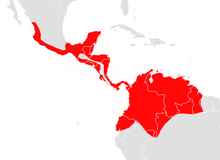Pipefruit bat
| Pipefruit bat | ||||||||||||
|---|---|---|---|---|---|---|---|---|---|---|---|---|

Pipefruit bat with piper arboleum |
||||||||||||
| Systematics | ||||||||||||
|
||||||||||||
| Scientific name | ||||||||||||
| Artibeus phaeotis | ||||||||||||
| ( Miller , 1902) |
The pipefruit bat ( Artibeus phaeotis ) is a bat species from the leaf-nosed family (Phyllostomidae), which is native to Central and South America.
description
The dwarf bat is, as its name suggests, one of the smallest actual fruit vampires with a head-to-trunk length of 51 to 60 mm and a maximum weight of 15.6 g. The fur is brown or gray, dense and soft, with the forearms also being hairy. The name Artibeus is derived from the Greek arti and beus , which refers to the presence of two white stripes on the face. The flight membrane is black, the ears dark brown and often with a yellow border. Like most representatives of the leaf noses , the pygmy bat also has a striking nasal leaf .
The species name is derived from the Greek phaios (= dusty) and refers to the grayish coat color of the dwarf bat. The pygmy bat can be confused regionally with Artibeus watsoni . In living animals, the two species can only be distinguished by the teeth and the color of the edges of the ears, although both characteristics are not very reliable. In some studies, therefore, either both species are combined as a species complex or they are separated using DNA analyzes.
Way of life
The pygmy bat mainly eats fruit, but also pollen and insects. During the day, the animals hang in small groups under modified leaves, so-called leaf tents. The leaves of bananas , heliconias and tropical macaws are gnawed along the central rib so that the leaf collapses and forms a kind of tent. The pygmy bat is seasonal and bimodal polyestrial , meaning that the females come into the estrus twice a year. In Costa Rica, females are pregnant with a single embryo in April and August / September.
distribution and habitat
The pygmy bat is distributed in three subspecies from Mexico to Ecuador , Colombia , Venezuela and Guyana . Thanks to its widespread use, the IUCN classifies its population as safe.
literature
- RM Timm: Artibeus phaeotis , Mammalian Species , No. 235 (1985): pp. 1-6. - Preview at JSTOR
